Unable to decide which is the best editor between Gutenberg vs Elementor? Worry not; we’re here to solve your query and ease your choice.
This article will discuss Gutenberg and Elementor and compare them based on their key features, ease of use, performance, and pricing. Gutenberg and Elementor help create a WordPress site by letting you add custom styles and various elements to the content.
But are Gutenberg and Elementor both similar? Which is better Gutenberg vs Elementor? Let’s find out.
Introduction: Gutenberg vs Elementor
Before we start comparing, let us briefly introduce Gutenberg and Elementor.
i) What is Gutenberg?
Gutenberg is the default WordPress editor with the block-based approach for editing each piece of content of your WordPress site. It was first introduced in December 2018 with WordPress version 5.0.
In the initial days, some developers and users disliked the concept of Gutenberg. However, Gutenberg is now considered as one of the major updates from WordPress.
On the other hand, WordPress is still providing the classic editor in the form of the WordPress Classic Editor plugin. So, you can go back to the old editor whenever you want.
Gutenberg has blocks for every element, from header to images. Those blocks can be easily added, arranged, and rearranged. At the same time, it helps to create visually intuitive content. Meanwhile, Gutenberg is a back-end builder different from page builders like Elementor, a front-end builder.
ii) What is Elementor?
Elementor is one of the most reputed page builders for WordPress that allows you to design your content on the front end using the drag and drop interface. The plugin was developed in 2016, and there is no looking back for it with over 5 million active users as of today.

The plugin lets you build every part of your WordPress site using its visual builder, giving you the liberty and flexibility to build and design what you want. Besides, you also get to see the real-time changes of your website while building with Elementor.
Over and above that, Elementor is an entirely free plugin and also has a premium version with advanced features. It comes with several pre-built elements called “widgets”, which have a set of custom controls.
These widgets are further divided into categories. Some of its widgets are the inner section, heading, image, text editor, button, and so on. They help in page building in a convenient and faster way. Also, they come in handy to beginners who lack coding knowledge or are not familiar with building websites.
Key Features: Gutenberg vs Elementor
It’s obvious that we should look at the key features while making the comparison. So, we’ve shortlisted some of the main features that Gutenberg and Elementor have in that process.
i) Gutenberg- Key Features
- Completely Free: Gutenberg is completely free, and you don’t have to spend a penny for it. It comes along with WordPress 5.0 and above versions.
- Compatible: Since the editor comes by default with the core WordPress, it’s highly compatible to build the WordPress website. Also, the theme and plugins developers are focused on building Gutenberg compatible themes and plugins.
- Developers can create custom Blocks: Gutenberg is developer-friendly as it seamlessly works with the third-party Gutenberg blocks plugins. Hence, the developer can create their custom block and use it with WordPress.
- Allows to Embed Content from Third-Party: Gutenberg has dedicated blocks that embed the content from other third-party sources like Soundcloud, Youtube, etc.
ii) Elementor- Key Features
- Free and Pro version: Elementor has two versions: free and pro. So, you can use the free version if you do not require many widgets, while you can also upgrade to the pro version in case if you want more widgets.
- Visual drag and drop builder: Elementor’s drag and drop interface makes adding the widgets into the post or page easy. Also, you don’t have to be concerned about the coding. Just drag the widgets and drop them where you want.
- Responsive Editing: To make the design look perfect on every device, you can switch to mobile view and modify the elements.
- Safe Mode: The safe mode in Elementor allows you to activate a safe environment for your site and isolates Elementor from WordPress themes and plugins. As a result, your WordPress site is secure from the error that might occur because of themes and plugins.
Final Verdict: In the case of features between Elementor vs Gutenberg, both have unique features and advantages.
Ease of Use: Gutenberg vs Elementor
Let’s compare the ease of use between Elementor vs Gutenberg.
i) Gutenberg- Ease of Use
Since Gutenberg comes as a default WordPress editor for WordPress, it’s quite easy to use Gutenberg without installing anything more.
To use the Gutenberg editor, you need to log in to your WordPress dashboard. On the left-hand side, click on Posts >> Add New.
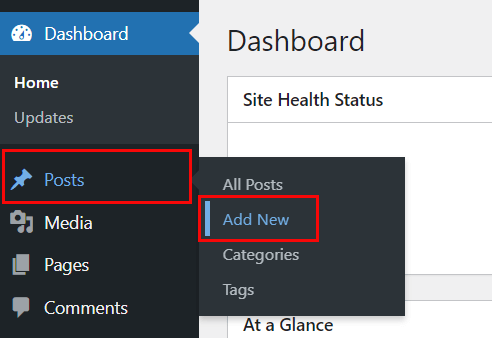
You’ll see a new page where you can add your content. Now, click on the icon [+] at the top-left corner to add a block.

It shows you the blocks available, or you can also search the block from the search bar.
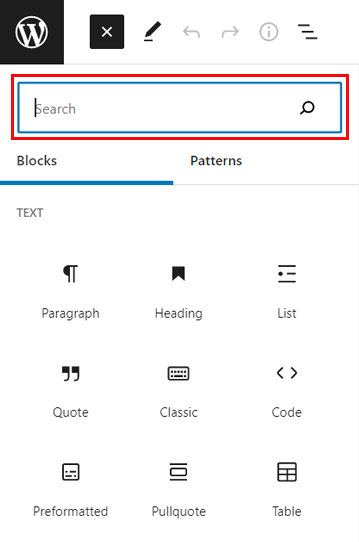
Using the blocks, you can create a post for your website. At the same time, the editor requires Gutenberg-ready themes like Zakra to work smoothly.
ii) Elementor -Ease of Use
Elementor has free and premium versions, which you can add from your WordPress dashboard. Here, we’re using the free version for reference. To install the free version go to the Plugins >> Add New
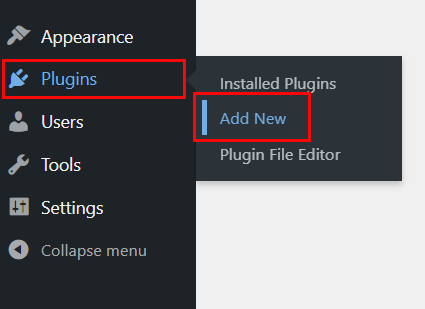
Now search for the Elementor from the search bar. Install and Activate the Elementor plugin when it appears on the search page.
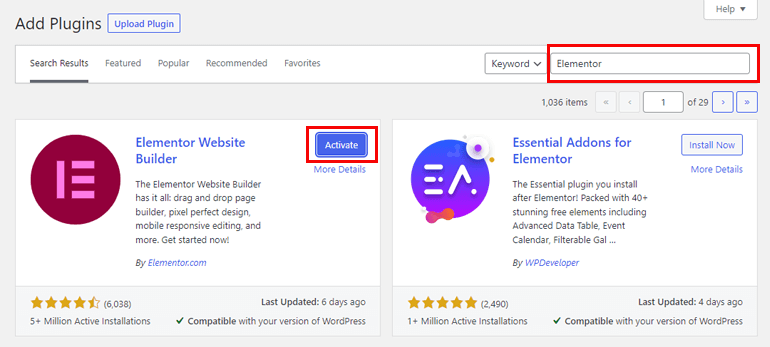
When you’ve activated the plugin, navigate yourself to the Posts >> Add New as mentioned above. When the page editor appears, at the top of your page, you’ll see Edit with Elementor.
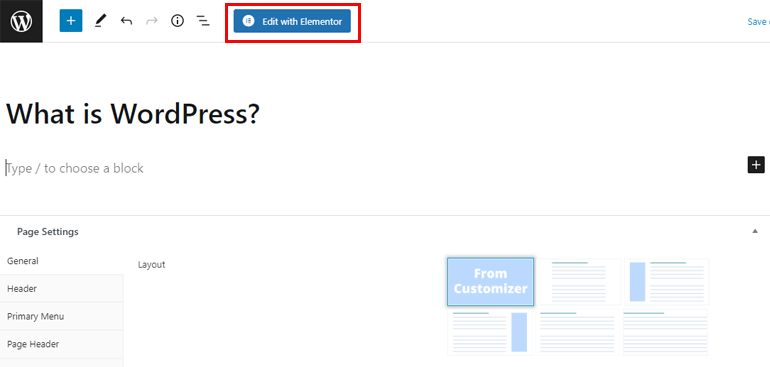
The Elementor page editor will appear. At the left, you’ll see a large collection of widgets. Now, start building the page for your website using the live editing page builder – Elementor.
All you need to do is click on Add New Section button then, drag and drop a widget from the left panel to the right side.
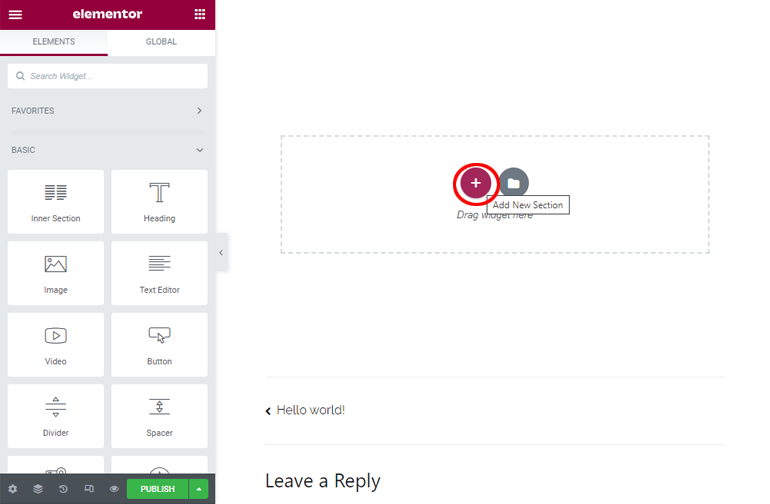
Next, you can also add from the pre-built pages. To choose the pages, click on the folder icon that says “Add Template” on hover.
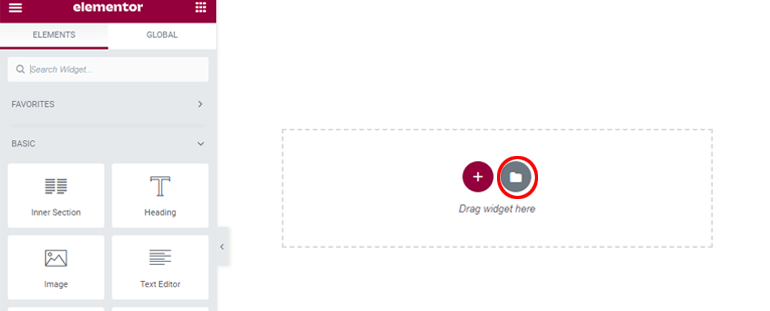
Select the page from the new pop-up that appears on your screen. Additionally, it also has many blocks that you can add to your post or page.
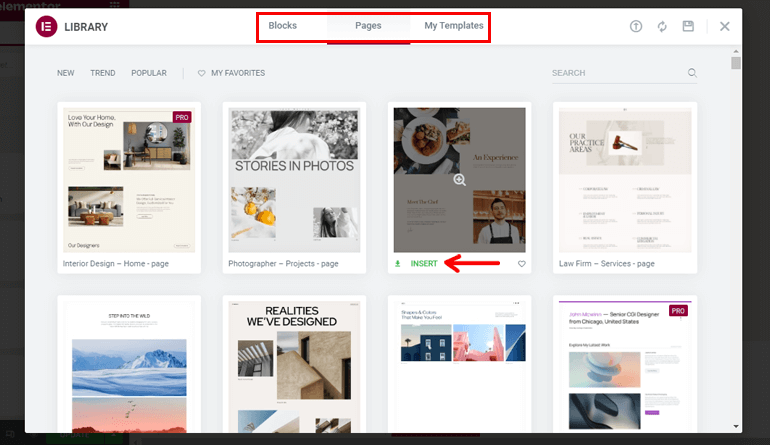
Choose according to your choice and hit the Insert button to add it. In the meantime, you need to have an account with Elementor to insert any blocks or pages. However, it’s a free account and easy to create within a few minutes.
Final Verdict: The beginner-friendly interface of both Elementor and Gutenberg allows you to build a WordPress website effortlessly.
Blocks and Widgets: Gutenberg vs Elementor
Gutenberg has blocks, whereas Elementor has widgets. So, let’s discuss them.
i) Gutenberg – Blocks
The WordPress Gutenberg editor has distinct blocks for every element. They transform the classical way of content creation into an extensive collection of elements. Moreover, the block provides an effortless way to build the pages and customize them, while the ancient editor required shortcodes or HTML code.
Each block has its individual setting, depending upon its purpose. There are many blocks types like buttons, heading, paragraphs, lists, separators, and so on. And you can choose the block type for your content and edit each block independently or even move them.
Alternatively, you can also add many custom blocks with addons and extensions. Or, if you’re a developer, you can create customize blocks. There are many custom Gutenberg block plugins, such as BlockArt.
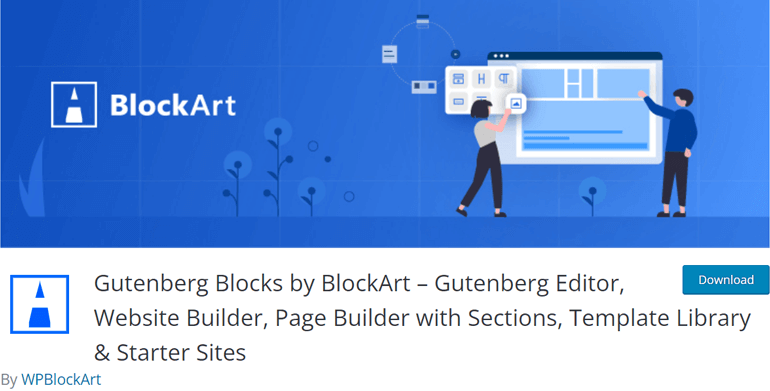
BlockArt is one of the best WordPress Gutenberg plugins available, providing additional blocks to make your content look great. It has advanced, and exclusive Gutenberg blocks like section, button, spacing, with plenty of settings and options for styling.
Besides, it also provides starter templates that you can import to the pages within a click. On top of that, BlockArt is available in-built with the Zakra theme. Isn’t that amazing?
ii) Elementor – Widgets
Just like the block in Gutenberg, Elementor has widgets. And these widgets include the inner section, heading, images, text editor, button, video, and so on.
There are 40+ widgets available in the free version and 90+ widgets in the premium version. For further convenience, many plugins have been developed to provide custom widgets and advanced features to use with Elementor.
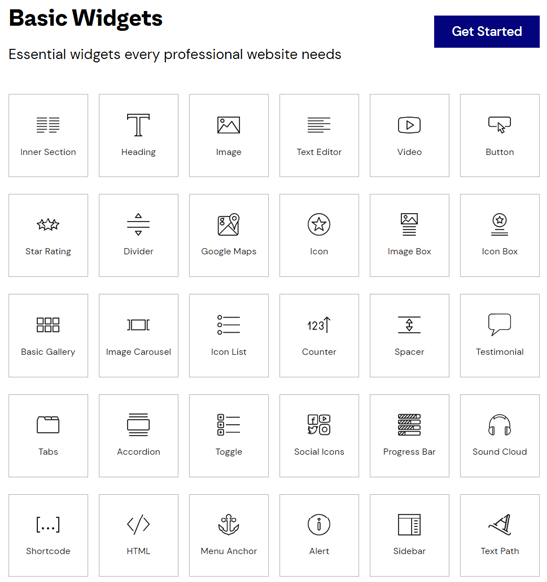
You can simply get those widgets through the addons and extension. While Elementor has its premium version, Companion Addons for Elementor is the most loved and valuable plugin with a unique library of Elementor widgets.
It comes with Zakra’s premium plan, using which you can add many extra widgets in your contents like slider, gallery, Everest Forms, and so on.
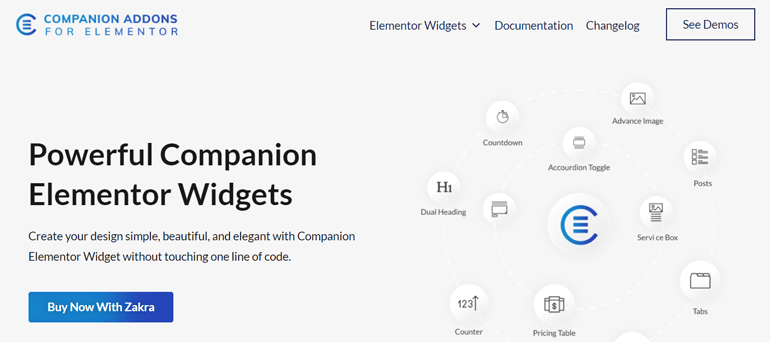
Final Verdict: Gutenberg and Elementor both have enough blocks and widgets, respectively. And if you want more, you can install BlockArt for extra blocks and Companion Addons for Elementor for extra widgets.
Performance: Gutenberg vs Elementor
Let’s now compare the performance between Elementor vs Gutenberg.
i) Gutenberg- Performance
Gutenberg has again an advantage in the performance as it’s the default WordPress block editor. It requires fewer resources to function correctly.
Further, the website performs at its best with Gutenberg because it’s compatible with almost all the themes and plugins. Some of the most popular Gutenberg-friendly themes are ColorMag, Flash, Cenote, and more.

If you say some themes or plugins are incompatible with Gutenberg, those are probably outdated.
ii) Elementor – Performance
When it comes to Elementor, it’s a whole new system and is not available by default in WordPress. This directly influences the performance of the website built using Elementor.
Additionally, some of the themes and plugins are not compatible with Elementor because the developers don’t need to build Elementor compatible themes and plugins compulsory.
However, for experienced developers, you can optimize your website’s performance easily by following the best practices like using proper tools, speed-optimized theme, or speed optimizations plugins.
On the bright side, Elementor comes with a responsive editor so that you can always design the site as per the devices. As a result, your site performs uniformly on all devices.
Final Verdict: Gutenberg outperforms Elementor in terms of performance.
Pricing: Gutenberg vs Elementor
Budget plays a vital role during the comparison between the two. So, find out which is cheaper between Gutenberg vs Elementor.
i) Gutenberg- Pricing
By now, you must have known that Gutenberg is free of cost and comes along with WordPress 5.0.
However, you can download the Gutenberg plugins to get more customized blocks. And those plugins are available in both free and premium versions.
ii) Elementor-Pricing
Elementor has a free version with 40+basic widgets. But to take full advantage of widgets, you require to upgrade to the pro version of Elementor.
The pro version of Elementor has more than 90 widgets. It includes widgets for theme and WooCommerce as well. You also get the responsive design, basic and pro templates, pro website kits, and theme builder with the pro version.
On the other hand, depending upon your plan, it provides premium support, VIP support, and an expert network profile. Meanwhile, the basic plan starts at $49 per year for one website and goes up to $999 per year for 1000 websites.

At the same time, other addons and extension plugins for Elementor are available in free as well as pro versions.
Final Verdict: In the case of price, Gutenberg is cheaper as it’s free. However, if you have the budget and want premium widgets, Elementor can also benefit you.
Gutenberg vs Elementor – Final Words
As we’re at the end of the comparison, we’ve listed some pros and cons for Gutenberg and Elementor below. You can have a great comparison between Elementor vs Gutenberg by looking at the points mentioned here.
Pros of Gutenberg
- Always free
- Developers can build their custom blocks
- Old posts are refactored automatically into a single classical block
- Block-search allows you to search for the required blocks quickly
- Since it comes with core WordPress, there are no compatibility issues
Cons of Gutenberg
- Less seamless compared to Elementor
- Might break the site if the theme and plugins are not compatible with Gutenberg
- The blocks are controlled by the theme that you install on your WordPress site
- Might break the site if the theme and plugins are not compatible with Gutenberg
Pros of Elementor
- Powerful pop-up builder
- Independent of the theme
- Has enough styling option
- Easy to style large and complex sites
- Provides more control to the layout of the page
Cons of Elementor
- Less optimized for speed
- Complex as compared to Gutenberg
- Free but requires pro version for more advanced features
Wrapping It Up!
That was our comparison for Gutenberg vs Elementor based on key features, ease of use, blocks, widgets, performance, and pricing. And after reading the article, we believe that you can now easily select a winner for yourself between Elementor vs Gutenberg.
Although Gutenberg is a block editor while Elementor is a page builder, WordPress supports both, and you can create your website using any of them. So, choose the one and get the work done.
Besides, the plugins like BlockArt and Companion Elementor Addon will help you to add additional functionalities to the page, posts, or website. If you still have any confusion about anything, please feel free to ask us anything through the comment section below.
You can as well visit our blog to learn more about building WordPress sites using Brizy builder and Zakra.


